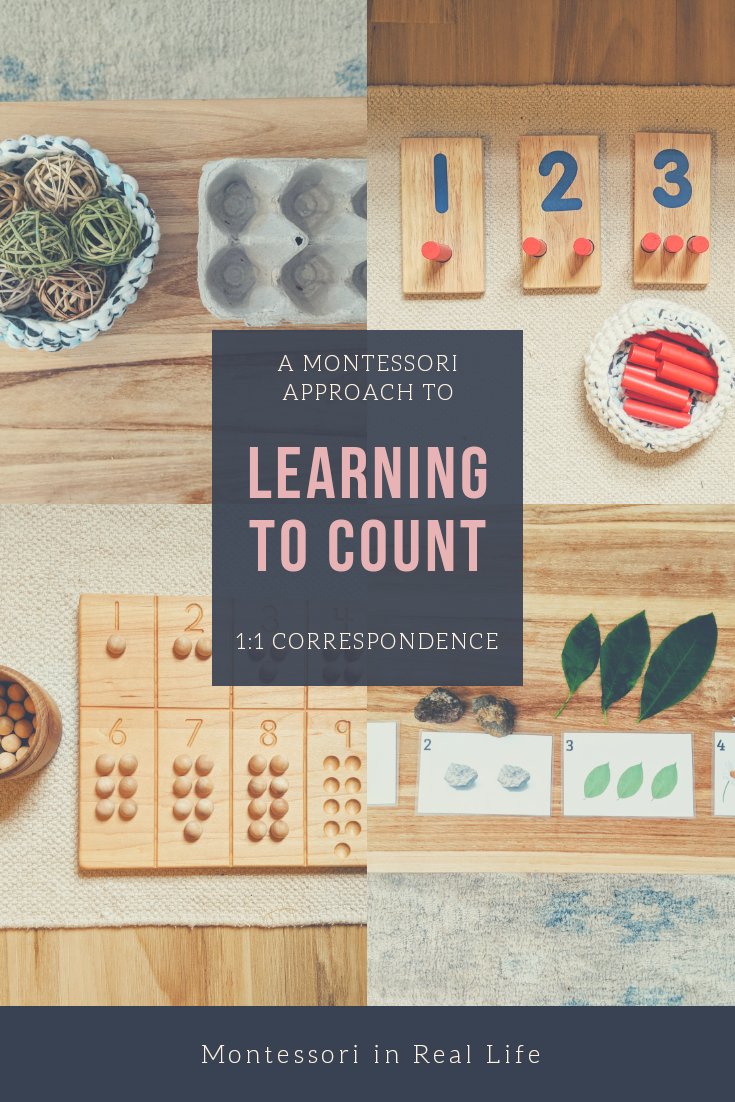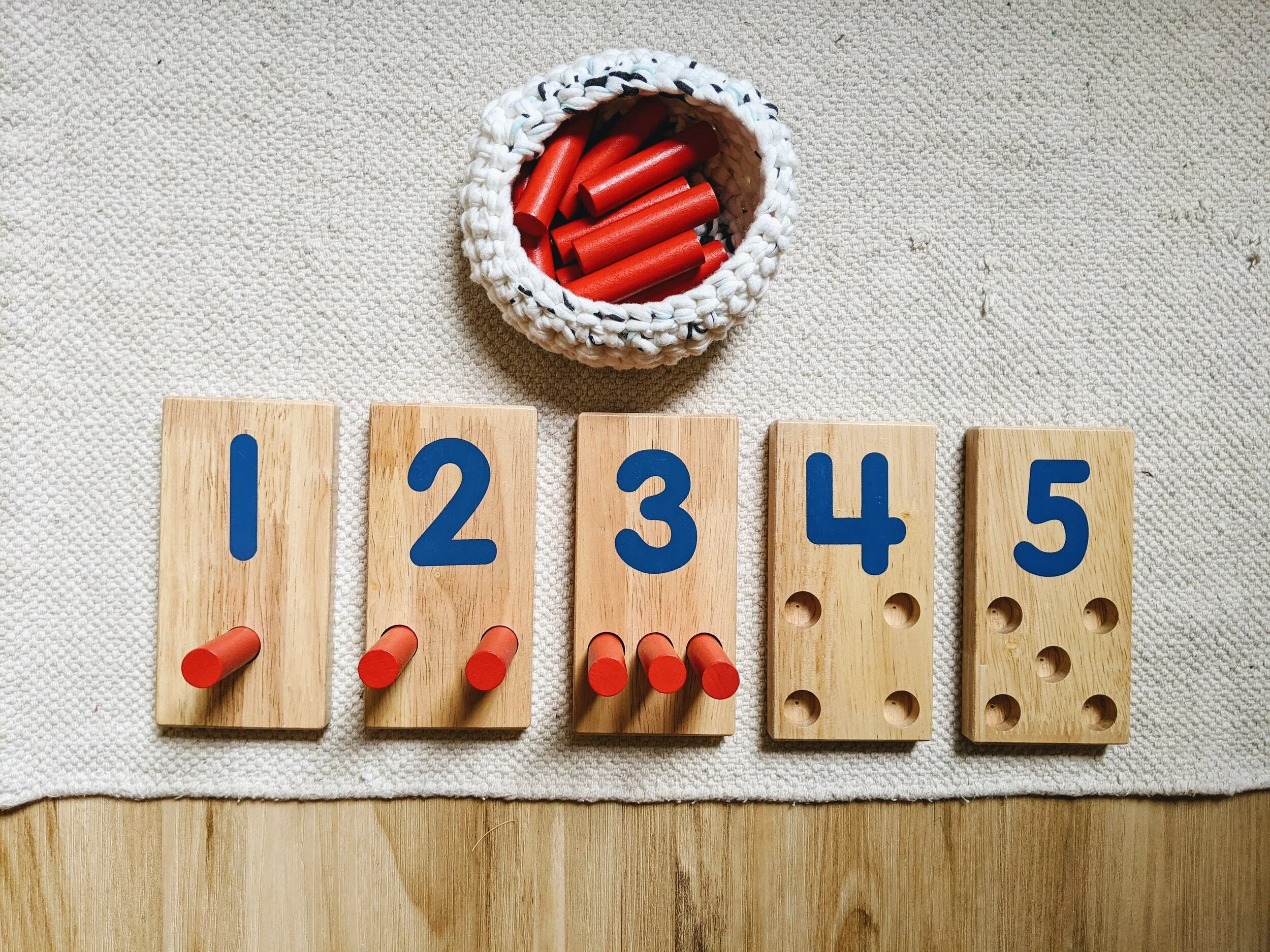Learning to Count: One-to-One Correspondence
Montessori in Real Life
The first step in introducing the concept of counting and numbers is one-to-one correspondence. One-to-one correspondence is the ability to count while pointing to one object at a time. It is assigning a number to one and only one object at a time. This is not rote counting or memorization but rather truly understanding the meaning of numbers. Memorizing how to count to ten doesn’t help a child unless they know what those numbers represent.
As with all Montessori learning, we introduce counting/one-to-one correspondence in the concrete first, using tangible objects. It is much easier for young children to grasp new concepts when they can touch, see, and experience them with physical counters. Only once they grasp the concept in the concrete (e.g. they count three objects one by one) do we introduce the abstract number symbols.
I try to avoid assigning ages to these activities, as all toddlers and preschoolers learn one-to-one correspondence and recognize numbers on different timelines. I will say that basic one-to-one correspondence activities can begin around 2 years, while counting cards and number hunt activities are best for ages 3 and up. Typically children don’t have a true understanding of what number symbols represent until after 3 or even 4 years old.
Keep in mind that children learn so much of what they know organically, without us really “teaching” them at all. When you are on walks, having conversations, or reading books, you probably already naturally count objects you see. Keep it up! Pointing as you count makes it more concrete for children. I also want to note that this is not necessarily how every Montessori parent or teacher would introduce numbers. These ideas are a mix of traditional Montessori and Montessori-inspired, and have worked well in our home!
Transferring and Matching - 1 to 1
This is one of the first activities you can do with your young toddler that teaches one-to-one correspondence. They are learning that one object corresponds to one space, and as they get older, are learning how to count the total objects. It is easy to set up with any kind of household object or object from nature, such as rocks or shells. When possible, we always start with objects or counters that are identical to each other. This helps to isolate the number from other variables such as color or shape. You can introduce more variety in the counters once they grasp the concept of the activity.
You can model for your toddler how you take one object from the bowl or basket and put it into one space on the tray. You want to be sure to have only the number of counters as the number of spaces in the tray, so that none are leftover (this enables toddlers to self-correct). It’s completely normal for young toddlers to place more than one counter in one space, or skip spaces. You don’t need to correct. You can model again sometime, and count up as you drop one counter in each space. It’s best to start small, with only three objects, and gradually use a full ice tray with 9 or more spaces. You can also add a fine motor challenge to this work with older toddlers by adding tongs for transferring.
Counting Cards
Once your toddler has mastered basic transferring/one-to-one correspondence as described above, you could introduce counting boards or cards. As explained above, it’s important when introducing this type of activity to keep the counters uniform and to only have the number of counters as spaces to fill. These peg boards, counting boards, or printable counting cards, allow your toddler to practice one-to-one correspondence while also seeing the corresponding number symbol. This helps them to recognize numbers and learn that each symbol represents a specific number of objects.
Number and Object Matching
Once D could master one-to-one correspondence with the same type of object (e.g. the pegs or the peas), we started to play a number/object matching game with these printable cards. This is a bit more complicated becuase each number corresponds to a differnet kind of object. These would be simple to make or draw with whatever objects you have around! More recently we did a version with nature objects. I always start with three or four, and then add on if and when she’s ready for more challenge.
Number Hunt Activity
Now that D has a pretty good idea of numbers (1-10) and their associated quantity, her favorite game to play is I-Spy with these polka dot number cards. Before she recognized the symbol, I would just say the number out loud or we’d count the dots together. So for example, I’d say “Can you go find three peg dolls?” If she comes back with a different number I’ll say “Oh you brought back two peg dolls!” I would ask her to pick one more and then we’d count together. I try not to say “that’s wrong”, but rather work together to find the right number, or just let it go and show her another time if she isn’t quite ready. Now that she recognizes number symbols up to five, we do the same number hunt with the number cards. It’s always more fun when we are outside!
Note: there is NO rush to learn number symbols and there are ONLY meaningful if a child truly understands that the symbol represents a quantity. Always start with counting. True number symbol recognition and understanding will emerge naturally through these activities, often around 3 or 4.
Note: This post contains affiliate links. If you purchase a product through one of these links, you won’t pay anything extra, but I will get a small commission, which helps keep this blog going. Thanks for supporting Montessori in Real Life!




















